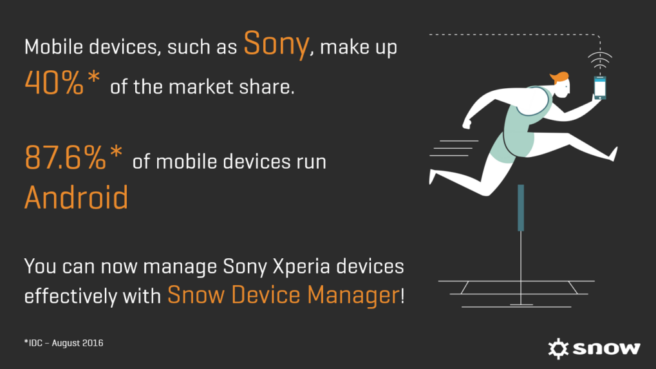Greater Choice for Mobile Technologies

Crowded and mature, that’s today’s market for smartphones and mobile devices. Apple and Samsung are assured leaders but others such as Sony and Microsoft have equally good brand recognition and strong offerings. Giving consumers and businesses the choice between handsets and operating systems leads to healthy competition and continual development of features and functionality.
The issues that many organizations face is that they need their workforces to be mobile to take advantage of new technologies and ways of working. No longer just the source for email, contacts, and calendars, employees are choosing to use apps, collaboration tools and data to be more productive and add value to the business.
Indeed, “The explosion of mobile apps in the enterprise reflects a change in focus from mobility as a communication and productivity enabler to a force for business transformation,” says Gartner[i].
THE CHALLENGE
But therein lies the problem, left unmanaged, this ever-increasing use of mobile technology and apps brings with it a number of financial and operational risks. Vendors are now expecting that users pay accordingly for use of these apps, especially in a work environment. To begin with, many apps were free or at least cheap to encourage their adoption.
Now app vendors are licensing apps much in the same way desktop software is licensed. This raises the risk that employees can unwittingly commit the organization to millions in unplanned software license and data costs or create new flaws in established security and compliance processes if the right controls are not in place.
As a result, many organizations are adopting Enterprise Mobility Management (EMM) solutions to gain full control over how phones and tablets are used to meet business needs whether in bring-your-own-device (BYOD) or corporate-owned-personally-enabled (COPE) scenarios.
In parallel device manufacturers have extended APIs to the EMM solution providers so that the mobile devices can be managed through these EMM solutions. Apple and Samsung have been pioneers in opening their APIs towards EMM-vendors making them able to provide secure services for their enterprise customers (interesting that it was Samsung as a device manufacturer rather than Google as the OS provider with Android).
With the recent release of APIs 8 and 9, Sony, is now on a par with Samsung. These APIs enable EMM vendors to provide the same device management controls as they do for other tablets and phones.
MORE CHOICE, BETTER NEGOTIATING POSITION
Samsung controls the largest market share of smartphone shipments – in Q22106 it reached 22% of the global smartphone market, with the Galaxy Note 7 becoming the most used device[ii]. In recent months though, the Korean chaebol has taken a bruising with the failure to stop its Galaxy Note 7 devices from overheating and has now withdrawn it from the market.
This problem may also have an impact on the development cycle of the Galaxy Note 8, indeed it may come to taint the Galaxy Note brand so much that it is ditched altogether by the conglomerate. Of course, this leaves the door wide open for others to capitalize on Samsung’s misfortunes as organizations who prefer Android over Apple look to provide their users with alternative devices.
IDC reports that 87.6% of mobile devices in 2016 run Android rather than Windows or iOS. Taking the example of Sony, for those businesses that want to deploy an EMM solution, they now can choose from a wider range of devices that support Android. Even if Samsung were not to be impacted with organizations replacing devices with a different brand, the availability of EMM functionality across another manufacturer’s range of mobile devices gives organizations the opportunity to negotiate for better deals between providers.
REGULAR REVIEWS
Referring again to the IT Market Clock for Enterprise Mobility 2016[iii], Gartner says in reference to a few of the hallmarks of market volatility and the hyper compression of technology life cycles in the current market, which is at an all-time high for enterprise mobile assets: “In this environment organizations must re-evaluate mobile technology roadmaps at least once every six months to a year (at maximum) to mitigate the risk of investing in uncompetitive mobile technologies.”
In addition, organizations need as wide a range of devices covered by EMM so that users may continue to use their device of choice, indeed where you run Apple, Sony, Samsung or Microsoft devices, you need the same level of cost control and security on all devices. Snow Device Manager’s latest release – from yesterday – supports Sony Xperia devices (C4, C5, Z2, Z” Tablet, Z3, Z4, Z5, M4, M5 and X-series) and includes vital EMM functionality such as kiosk mode (setting up a device with one app only mode), roaming, data thresholds and limits, disabling tethering, NFC, Wi-Fi, Bluetooth, mobile data or the installation of non-market apps.
Other limits such as enabling or disabling clipboard, locking wallpaper ensure the organization is in full control to mitigate most financial and operational risks.
Furthermore, this release introduces support for Windows 10 devices such as tablets (Surface) and desktops. The new functionality for provisioning Windows 10 devices with e-mail settings, Wi-Fi settings and apps makes it possible to manage laptops as you would mobile devices– I’ll stress the importance of all this in a future blog.
In the meantime, if you want to offer a broad device range for your users, yet ensure you have the necessary controls and management why not download The Ten Top Things you should know about Snow Device Manager and see how Snow’s solution gives equal focus to the user experience as well as mobile device control.
[i] IT Market Clock for Enterprise Mobility, 2016. Published: 7 October 2016. Analyst(s): Bryan Taylor [ii] IDC – August 2016 [iii] IT Market Clock for Enterprise Mobility, 2016. Published: 7 October 2016. Analyst(s): Bryan Taylor